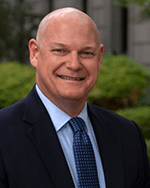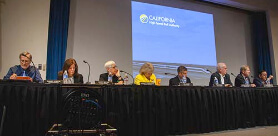CEO Report – October 2019
 PowerPoint: Where We Are and Where We Are Going
PowerPoint: Where We Are and Where We Are Going
While we focus extensively on the status of our work in the Central Valley, there is a lot of discussion underway regarding where we are with the broader program and what’s next.
This PowerPoint presentation shows a map of our Phase 1 system – from San Francisco to Los Angeles/Anaheim as well as future Phase 2 extensions to Sacramento and San Diego. It summarizes our mission, as articulated in our enabling statutes, which is: To initiate the construction of a high-speed train system that utilizes an alignment and technology capable of sustained speeds of 200 miles per hour or greater.
Because we’ve never had all the funding required to build full system, the Board has adopted three principles to guide the implementation of the system.
- Initiate high-speed rail service in California as soon as possible.
- Make strategic, concurrent investments that will be linked over time and provide mobility, economic and environmental benefits at the earliest possible time.
- Position ourselves to construct additional segments as funding becomes available.
The map on Slide 3 is a snapshot of where we generally are today with the advancement of electrified high-speed rail in California. In 2020, there will be 350 miles of electrified high-speed rail in project development in California. We are moving forward in the Central Valley to develop a 170-mile Merced to Bakersfield corridor and by the November Board meeting, we will have the Record of Decision for the Poplar to Bakersfield section. In the Bay Area, work is underway to electrify the 51-mile Caltrain corridor. The dashed lines show the sections where environmental clearance is underway for the rest of the Phase 1 system.
Of note, there is the emergence of a new and important player in Southern California with Virgin (Brightline) Trains in development between Las Vegas and Victorville — 130 miles of that system will be in California. There have been two fundamental changes on the Brightline/Virgin Trains system. First is an ownership change with the involvement of Brightline, which operates trains in Florida, and Virgin Trains which is owned by Richard Branson, founder of Virgin Airlines. Both clearly bring solid experience in transportation to this program. The second development is their decision to switch from planning for diesel trains to electrified high-speed trains that will travel at 150 mph.
Slide 4 shows where we will be in 24 months. Specifically, by 2022, the full 520-mile Phase 1 system will be environmentally cleared. Virgin Trains intend to break ground as early as 2020 and should be well into construction. Caltrain corridor electrification will be close to completion and we will have 170 miles of high-speed rail under construction in the Central Valley. With that, 350 miles of electric high-speed rail could be under construction in California.
As shown on Slide 5, the Virgin Trains system is currently planned to run 180 miles between Las Vegas and Victorville. The system is being developed as a public private partnership. Virgin Trains is taking the investment and ridership risk and California is an important partner because the system will run primarily on public right-of-way in the I-15 Corridor. In addition, the state’s Debt Limit Allocation Committee recommended approval of tax-exempt bonding authority and Virgin Trains will be going before the State Infrastructure Bank for approval to issue private activity bonds. This will be a unique opportunity to demonstrate a new source of financing for high-speed rail in California.
As discussed on Slides 5 and 6, the Authority, together with CalSTA has had a partnership with this entity through a Memorandum of Understanding (MOU) which was recently updated in January. We intend to work closely with them particularly now that they are committed to electrified service. Through our agreement we will share information and explore the opportunity to advance an extension through the High Desert Corridor from Victorville to Palmdale where our systems could connect in the future. We will also evaluate opportunities for joint procurements and for interoperability on our two systems. This represents a significant introduction of high-speed rail in the Southern California region and could present some exciting synergies between our two systems including higher ridership potential and possibly future public-private partnerships for the extension south to Los Angeles.
Even as we move forward with construction in the Central Valley, it’s important to note that we are making investments in Northern and Southern California. As shown on Slide 7, last month we signed a Memorandum of Understanding with LA Metro for the Link US project, committing a total of $441 million to the project. As part of our work to environmentally clear the Burbank-Anaheim corridor, we are also clearing it for investments to be made by other operators in that important and heavily used rail corridor. The Authority has contributed $398 million for Connectivity Projects including, for example, $115 million for the Regional Connector Transit Corridor project for a total investment of $1.3 billion. That’s an important part of the State’s overall investment of $4.4 billion in rail infrastructure in Southern California.
In the Bay Area (Slide 8), we are an important funding partner, contributing $1.6 billion in Proposition 1A and Cap and Trade funds to projects on the Peninsula including $714 million to electrify the Caltrain corridor and $84 million for the San Mateo Grade Separation Project, both of which are under construction. The Authority has also contributed $543 million for Connectivity Projects such as $61 million for the Central Subway Project in San Francisco and $140 million to BART for Millbrae Station track improvements and vehicle purchases.
Lastly, Slide 9 shows our updated environmental schedule which indicates that the full Phase 1 system will be environmentally cleared within the next 18 to 24 months. By completing this schedule, we will not only meet the terms of our federal grant agreement, we will also be positioned to move forward with project development in these sections as funding becomes available. This provides the Authority the opportunity to demonstrate that we are applying the lessons we have learned in the 119-mile Central Valley Segment by moving forward with project development activities in the correct sequence.
The first opportunity to do that is in the Poplar to Bakersfield section where we will have the Record of Decision (ROD) for the Locally Generated Alternative before the November Board meeting, followed by the ROD for the Central Valley Wye in the fall of 2020. This slide also shows when we anticipate releasing draft environmental documents for public comment. As this schedule shows, while we have paid some price in schedule due to federal disengagement, we are still well ahead of our FRA grant schedule to environmentally clear the full 520-mile project by the December 2022 grant deadline.
In sum, there is a lot of progress going on with electrified high-speed rail in California.


